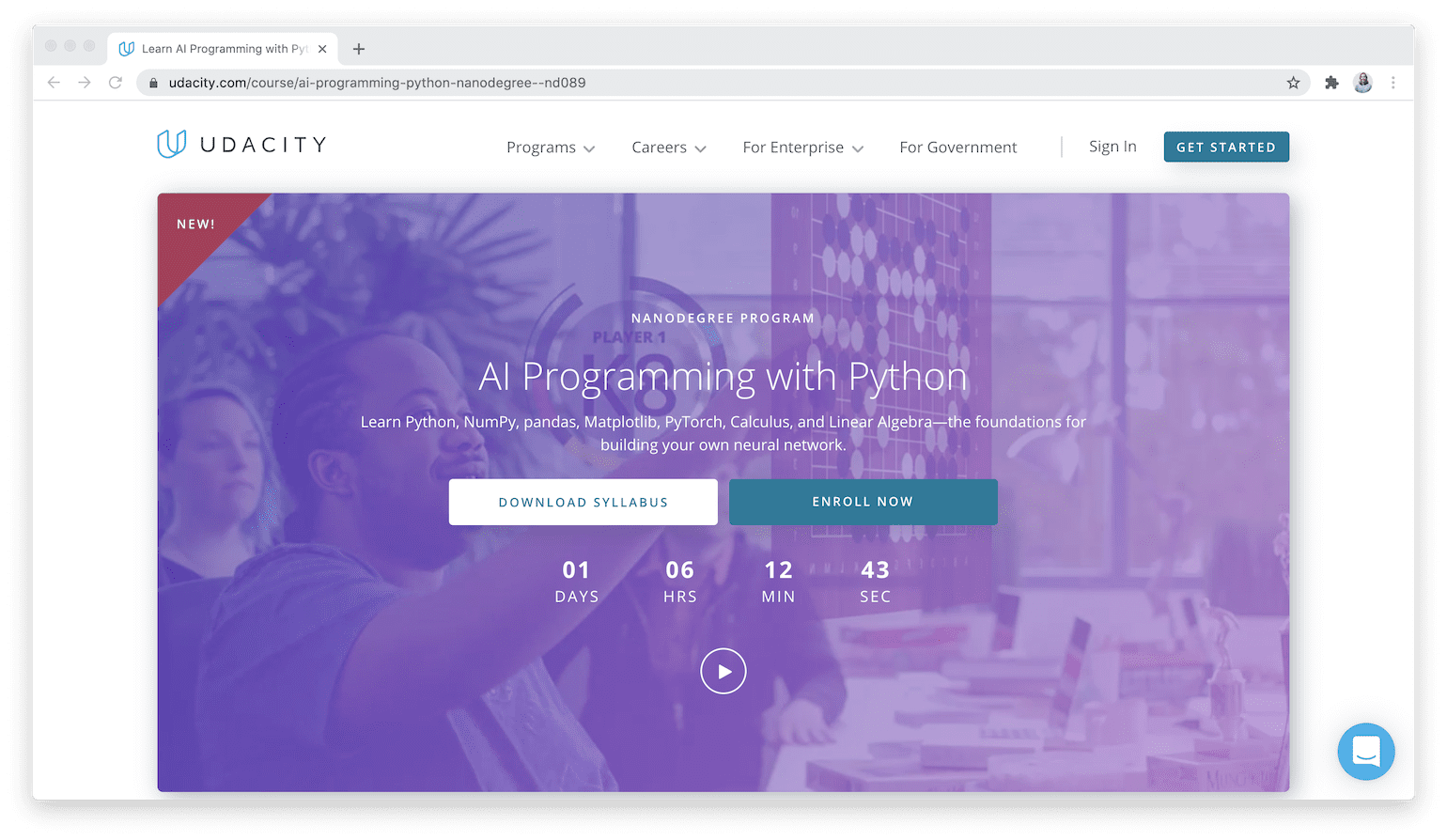When you’re exploring the idea of learning technology skills, it’s smart to consider which ones will be the most in-demand skills for the future. Tech is a broad field, and there are a lot of interesting directions you can go in. But it’s also a field that evolves rapidly, so you’ll want to keep your finger on the pulse of hot technologies and high-demand skills for the next 10 years.
In this article, we’ll look at some top technical skills of the future, how much demand exists for each skill, and where to go to start your learning journey.
Without further ado, here are 18 of the top digital skills to learn in 2022—plus where to find the online technical training you need to become a pro at these future-ready skills.
Disclosure: I’m a proud affiliate for some of the platforms mentioned in this post. If you buy a course through my links on this page, I may get a small commission for referring you. Thanks!
Table of Contents
- Top Tech Skill #1: Artificial Intelligence
- Top Tech Skill #2: Machine Learning
- Top Tech Skill #3: Data Science & Analytics
- Top Tech Skill #4: Data Engineering
- Top Tech Skill #5: Data Visualization
- Top Tech Skill #6: Network and Information Security (Cybersecurity)
- Top Tech Skill #7: Cloud Computing/AWS
- Top Tech Skill #8: Extended Reality (Virtual Reality and Augmented Reality)
- Top Tech Skill #9: Internet of Things (IoT)
- Top Tech Skill #10: UI/UX Design
- Top Tech Skill #11: Mobile Development
- Top Tech Skill #12: Blockchain
- Top Tech Skill #13: Quantum Computing
- Top Tech Skill #14: Robotics
- Top Tech Skill #15: Product Management
- Top Tech Skill #16: Salesforce/CRMs
- Top Tech Skill #17: Low-Code Platforms
- Top Tech Skill #18: Programming Languages in General
- Bonus: Soft Skills That Can Help Your Technical Career
⭐ Sponsored Resource ⭐
Get the skills you need for a career in data with DataCamp.
For a limited time, Learn to Code With Me readers can enjoy a 25% discount on DataCamp Learn Premium and DataCamp Teams.
Just click this link and the discount will be automatically applied. Offer ends March 21, 2023.
Please note that pricing listed below may change in the future!
Top Tech Skill #1: Artificial Intelligence
AI is rapidly changing the landscape of work, making it an exciting time for programmers looking for something new. Hiring growth for AI practitioners grew 32% between 2019 and 2020. Because of its increasingly widespread adoption, AI specialists earned LinkedIn’s #1 emerging jobs spot in 2020 and is #15 on their 2021 list of “jobs on the rise.”
There is crossover with machine learning here (which you’ll learn about next!), but the key difference is that AI is a broader concept pertaining to machines designed to act intelligently like humans, whereas machine learning relies on devices making sense of a specific set of data. Top skills to know within artificial intelligence include C++, Amazon Web Services (AWS) and Python.
Now that AI has become more mainstream (and businesses are implementing AI to keep up with demand during COVID-19 and the post-pandemic world), companies will be looking for people with specific areas of expertise in AI in 2022, such as natural language processing (NLP), automated speech recognition (ASR) and automation. Not only that, but according to a 2020 UiPath survey, 70% of C-level executives want even non-technical employees to have some automation and AI skills.
Another emerging AI skill to consider learning in 2022? AIOps (short for artificial intelligence for IT operations). This future-ready skill is similar to DevOps, but is specifically for AI-related projects, combining big data and machine learning to automate the path from development to production.
AI could even help solve the semiconductor chip shortage, with Google claiming that it’s using AI to design chips faster than humans. Yet another timely reason this is a top technology to learn in 2022!
Start coding now
Stop waiting and start learning! Get my 10 tips on teaching yourself how to code.
🌟 Quick facts about AI as a tech career:
- Average salary: $125k average across various AI careers
- 43% of businesses today are leveraging some form of AI
- Artificial intelligence specialties can benefit a variety of tech careers, from software engineers to data scientists to product managers.
➡️ Where to learn it: AI Programming With Python on Udacity
What the course covers:
If you know basic algebra and you have some coding skills, you can take this Nanodegree from Udacity and learn the foundations of artificial intelligence. You’ll learn Python, NumPy, pandas, Matplotlib, PyTorch, Calculus, and Linear Algebra—everything you need to build your own neural network.
Course facts:
- Course Name: AI Programming with Python
- Platform: Udacity
- Instructed by: Ortal Arel, Juan Delgado, and more
- Price: $339 per month for 3 months
- Skill level: Beginner
- Enroll in the course here
Why this course?
This course focuses on Python, which is one of the main languages used in AI, and neural networks, which are the main building blocks of AI. It therefore equips you with the foundational in-demand skills that you’ll need to start a career in artificial intelligence.
☝️ Back to the table of contents
Top Tech Skill #2: Machine Learning
Machine learning is one of the most innovative and exciting fields moving into the future, making it one of the best skills to learn in 2022 (and one of the most lucrative to boot!). From Siri and Alexa to chatbots to predictive analysis to self-driving cars, there are a ton of uses for these futuristic hot technologies. Machine learning has even been used to help predict how infectious a patient with COVID-19 is likely to be and speed up drug development.
Those who begin taking online courses in machine learning now will still be getting in relatively early, as demand is only increasing from here. According to Algorithmia’s third annual survey, 76% of enterprises prioritized AI and machine learning over other IT initiatives in 2021. Common use cases for machine learning include recommender systems, generating customer insights and intelligence, and detecting fraud.
Machine learning technical skills can be applied to every industry, including healthcare, education, finance, etc. Translation? The possibilities are endless, and you can apply your machine learning skills of the future to a role that suits your personality and interests.
Learn more about the difference between AI and machine learning technology skills and what to do if you want a career in machine learning in this interview with CTO Allan Leinwand.
🌟 Quick facts about machine learning as a tech career:
- Average salary: $135,460+ (Machine Learning Engineer)
- The number of machine learning startups listed in Crunchbase increased by 8.2% since 2020 (9,977 to 9,216) and increased 14.6% since 2019
- Netflix uses machine learning to make recommendations to its users
- There are over 150,000 open positions listed on LinkedIn alone
Below are two of the best machine learning courses available. Alternatively, see my article for even more machine learning courses.
➡️ Where to learn it: Machine Learning on Coursera
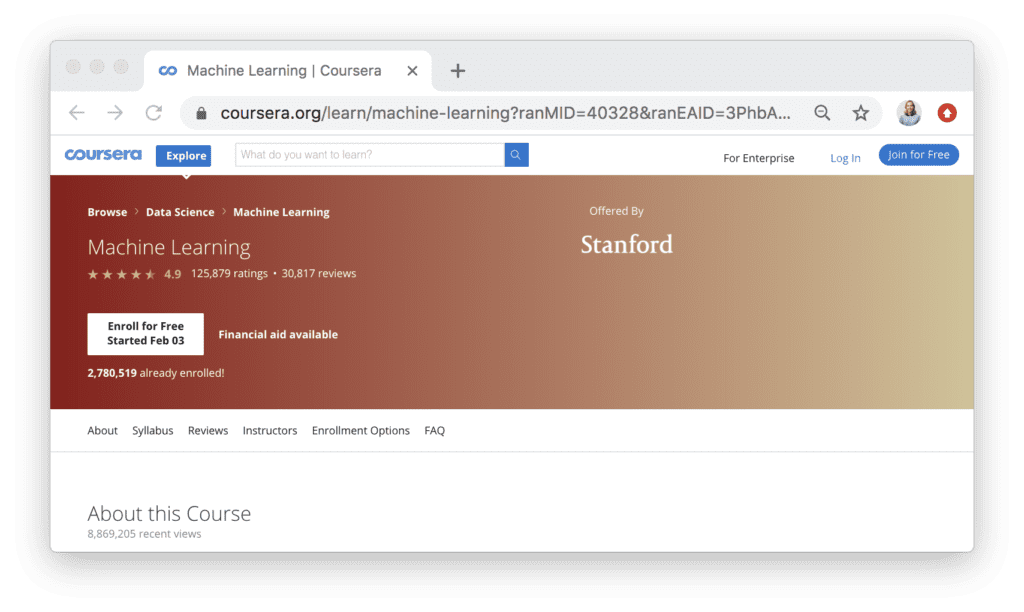
What the course covers:
Broad intro to the entire machine learning workflow, including neural networks, statistical pattern recognition, deep learning, unsupervised learning, anomaly detection, recommender systems, and more.
Course facts:
- Course Name: Machine Learning
- Platform: Coursera
- Instructed by: Andrew Ng (cofounder of Coursera)
- Price: Free! (for the audit option, no graded items) or $79 (with certificate & graded assignments)
- Skill level: Beginner/Intermediate (requires basic understanding of linear algebra)
- Enroll in the course here
Why this course?
It has a 4.9-star rating (out of over 165,000 ratings), was created by Stanford University, touches on the theories behind machine learning as well as its practical applications, and is taught by the cofounder of Coursera!
➡️ Where to learn it: Learn the Basics of Machine Learning on Codecademy
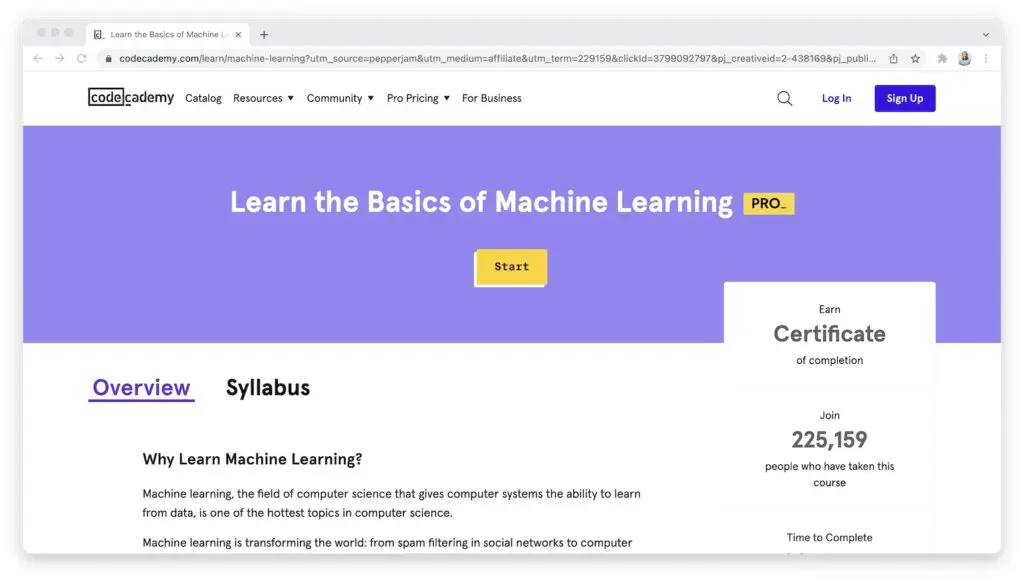
What the course covers:
This course covers the foundational machine learning algorithms that will help you advance in your career. Whether you’re trying to analyze a dataset using machine learning, or you’re a data analyst trying to upgrade your future-ready skills, this course is the best place to start.
Course facts:
- Course Name: Learn the Basics of Machine Learning
- Platform: Codecademy
- Price: Free with a 7-day trial of Codecademy Pro, then $19.99/month
- Skill level: Intermediate (requires knowledge of Python, including functions, control flow, lists, and loops)
- Enroll in the course here
Why this course?
In just 20 hours of learning, this course takes you from knowing the basics to a deeper understanding of machine learning, including how it’s used, the important algorithms, and how to build your own game playing AI. At the end of the course, you’ll get a certificate of completion.
☝️ Back to the table of contents
Top Tech Skill #3: Data Science & Analytics
Two consistently in-demand tech skills within Big Data include data science and data analytics. Revenue from Big Data applications and analytics is projected to grow from $5.3B in 2018 to $19.4B in 2026. The industries investing most heavily in Big Data are banking, manufacturing, professional services (e.g., financial advisors, accounting firms) and the federal government, with their total investment estimated to be $274.3 billion in 2022.
59% of companies are adopting big data analytics to accelerate their decision-making and bring greater accuracy. This is part of why data science has earned a top spot on LinkedIn’s emerging jobs report all three years the report has been conducted.
Data analysis is the more entry-level skill, whereas data science gets more advanced, but the careers are still cousins. Industries needing data professionals span education, finance, health, software, and more.
Learn more about data analysis and data science from my blog posts and podcast episodes:
- What Is Data Analysis and How Can You Start Learning It Today?
- S4E5: How to Get Started in Data Analytics With Ben Collins
- S4E9: How to Become a Data Scientist Without a Degree With Fernando Hidalgo
- S4E15: How to Teach Yourself Data Science With David Venturi
- Python for Data Science: A Beginner’s Guide
🌟 Quick facts about data science and analytics careers:
- Average salary: $62,365 for data analysts and $83,094 for data scientists
- Data scientist is the second-best job in America, according to Glassdoor’s annual Best Jobs in America report for 2021
- There was a shortage of 250,000 data science professionals in 2020
➡️ Where to learn it: Big Data Specialization on Coursera
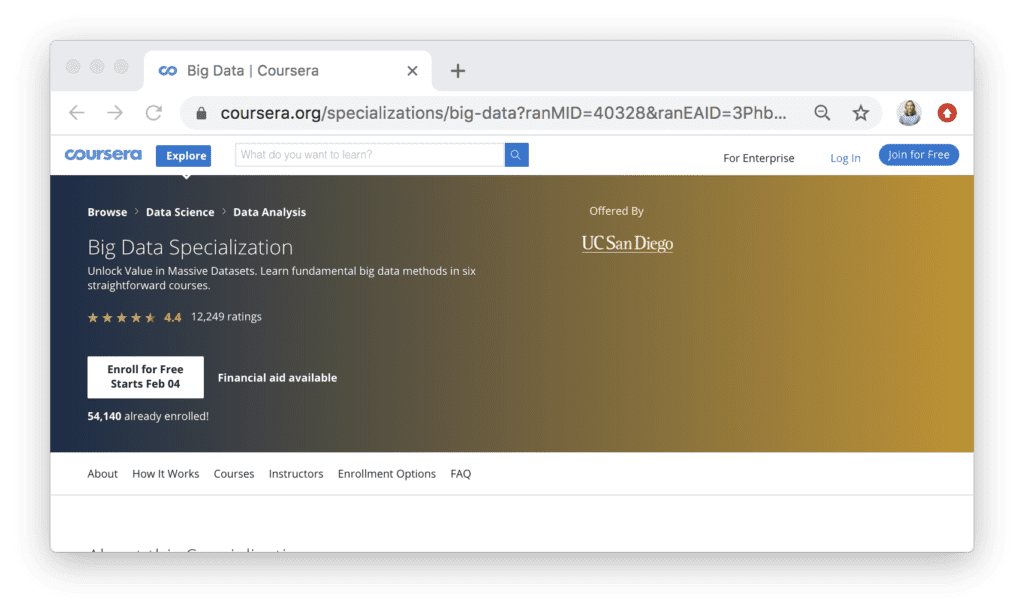
What the course covers:
Drive better business decisions with an overview of how big data is organized, analyzed, and interpreted. Apply your insights to real-world problems and questions.
Course facts:
- Course Name: Big Data Specialization
- Platform: Coursera
- Instructed by: Ilkay Altintas, Amarnath Gupta and Mai Nguyen
- Price: $49 per month with Coursera subscription
- Skill level: Beginner
- Enroll in the course here
Why this course?
Taught by San Diego Supercomputer Center experts, involves hands-on activities, and you’ll get a comprehensive knowledge of the entire Big Data industry so you can go on to choose a specialization in data analytics, science, engineering, etc.
➡️ Where to learn it: Data Science Theory Crash Course
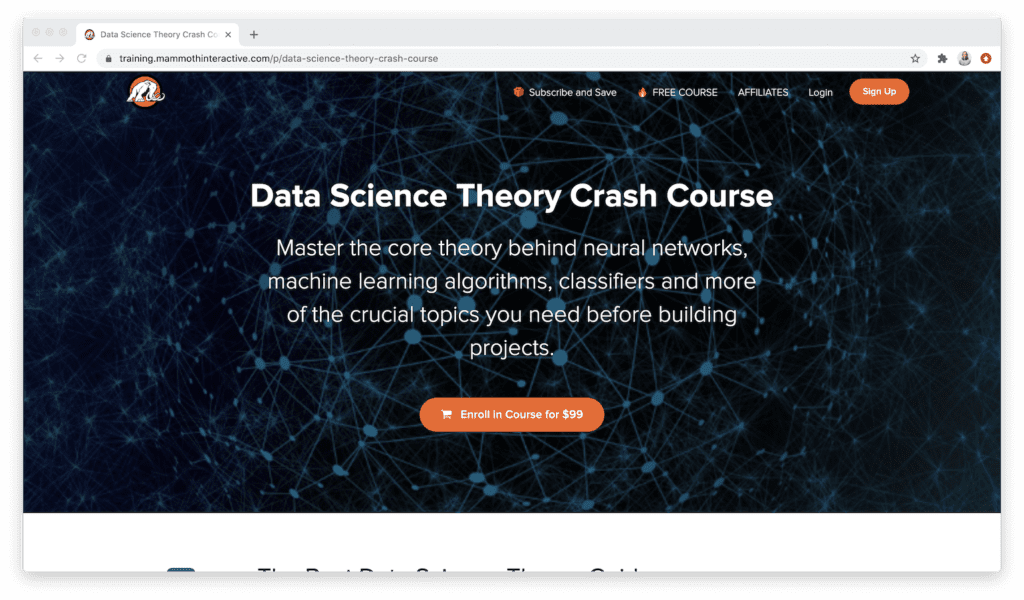
What the course covers:
Master the core theory behind neural networks, machine learning algorithms, classifiers, and more of the crucial topics you need before building projects.
Course facts:
- Course Name: Data Science Theory Crash Course
- Platform: Mammoth Interactive
- Instructed by: Alexandra Kropova
- Price: $99
- Skill level: Beginner
- Enroll in the course here
Why this course?
Taught by San Diego Supercomputer Center experts, involves hands-on activities, and you’ll get a comprehensive knowledge of the entire Big Data industry so you can go on to choose a specialization in data analytics, science, engineering, etc.
☝️ Back to the table of contents
Top Tech Skill #4: Data Engineering
Data engineering is separate from data science, but the former is what enables the latter to exist. Data engineers build the infrastructure and tools that data scientists rely on to conduct their own work.
Since 2015, the hiring growth rate of this technology job has increased by nearly 35% across a wide variety of industries. And according to Udemy’s November 2021 Workplace Learning Skills Index, data engineering is one of the top skills surging in the US (up 655%).
There’s no better time for U.S. citizens to enter the field, due to changes in immigration laws. “Following recent government policy changes in the H1-B Visa application process, demand for US citizen data engineers has increased drastically and shows no signs of easing,” writes Sam Brown.
Hear about a day in the life of a data engineer director at Etsy in this podcast interview with Jenn Clevenger.
🌟 Quick facts about data engineering as a tech career:
- Average salary: $92,934 per year
- In some ways, data engineering is more closely related to software engineering than to other data roles.
- Growth of data engineering roles has historically outpaced growth for data scientist jobs. In fact, data science interviews grew by 10% compared to data engineering interviews which grew by 40% in 2020.
➡️ Where to learn it: An Introduction to Google Cloud Platform for Data Engineers on Udemy
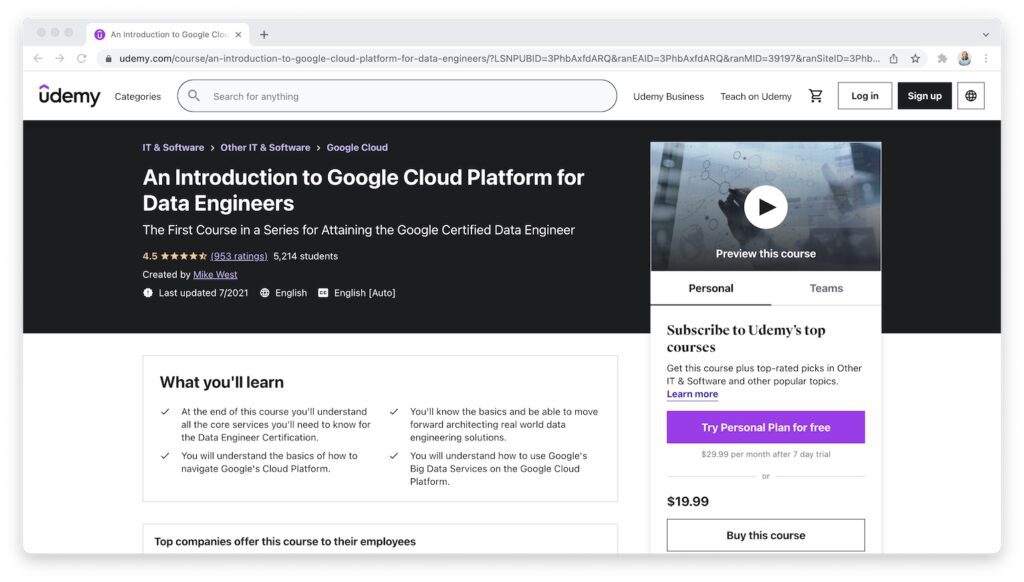
What the course covers:
All the core services you’ll need to know for the Google Cloud Data Engineer test, the basics of how to use Google Cloud Platform
Course facts:
- Course Name: An Introduction to Google Cloud Platform for Data Engineers
- Platform: Udemy
- Instructed by: Mike West
- Price: $19.99
- Skill level: Intermediate (you’ll need a basic understanding of cloud technologies and SQL)
- Enroll in the course here
Why this course?
It’s the first course in a series geared at helping you get the Google Cloud Professional Data Engineer Certificate.
➡️ Where to learn it: Data Engineer with Python Career Track on Datacamp
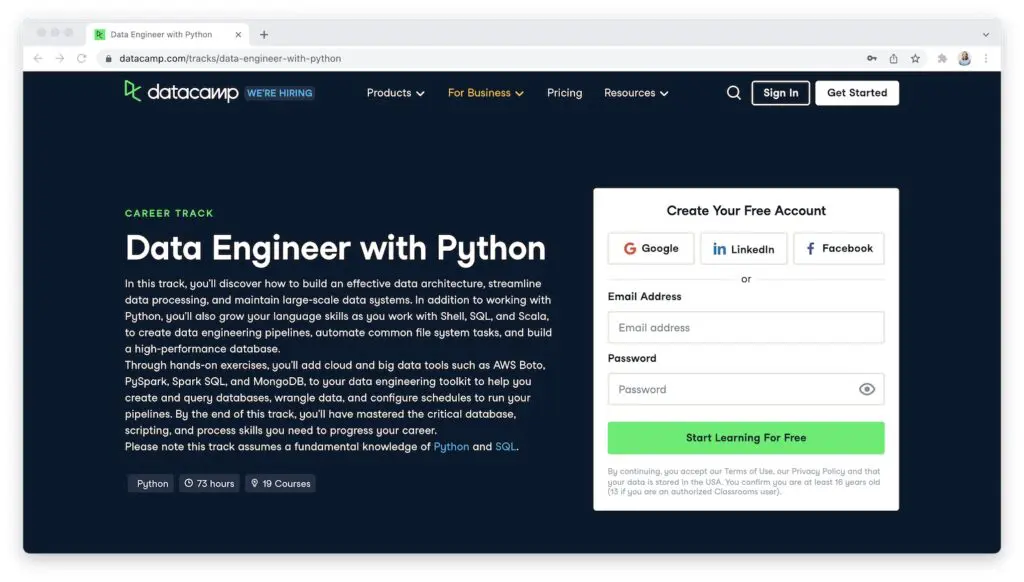
What the course covers:
This career path teaches you how to build an effective data architecture, streamline data processing, and maintain large-scale data systems. You’ll learn to work with technologies like Python, Shell, SQL, and Scala.
Course facts:
- Course Name: Data Engineer with Python
- Platform: Datacamp
- Price: $25/month with a Datacamp subscription
- Skill level: Intermediate (you’ll need a basic understanding of Python and SQL.)
- Enroll in the course here
Why this course?
It includes hands-on exercises, is taught by several real data scientists/software engineers, and it’s very comprehensive!
Start coding now
Stop waiting and start learning! Get my 10 tips on teaching yourself how to code.
☝️ Back to the table of contents
Top Tech Skill #5: Data Visualization
Data visualization is a way to help people understand the significance of data by placing it in a visual context. For instance, by turning spreadsheets or reports into charts and graphs that can be easily understood. This skill is commonly used by data scientists and data analysts, but can also be helpful in digital marketing roles.
Think of this career as a bridge between technical and non-technical roles. You’re taking the data collected by analysts and transforming it into a form anyone can understand. It’s one of the top digital skills to learn in 2022 because with all the data careers out there, companies need skilled data interpreters and communicators.
🌟 Quick facts about data visualization as a tech career:
- Average salary: $98,264 per year for data visualization engineers
- It’s in demand because employers can make sense of large amounts of data to drive real business results. For example, it can help them predict sales volume, understand what factors influence human behavior, identify areas in the business that can be improved, identify trends, relationships, patterns, etc.
- It’s a blend of science and art: raw information meeting visually appealing mediums.
- Data visualization is the key to “bringing the power of Big Data to the mainstream.”
➡️ Where to learn it: Data Visualization for All on edX
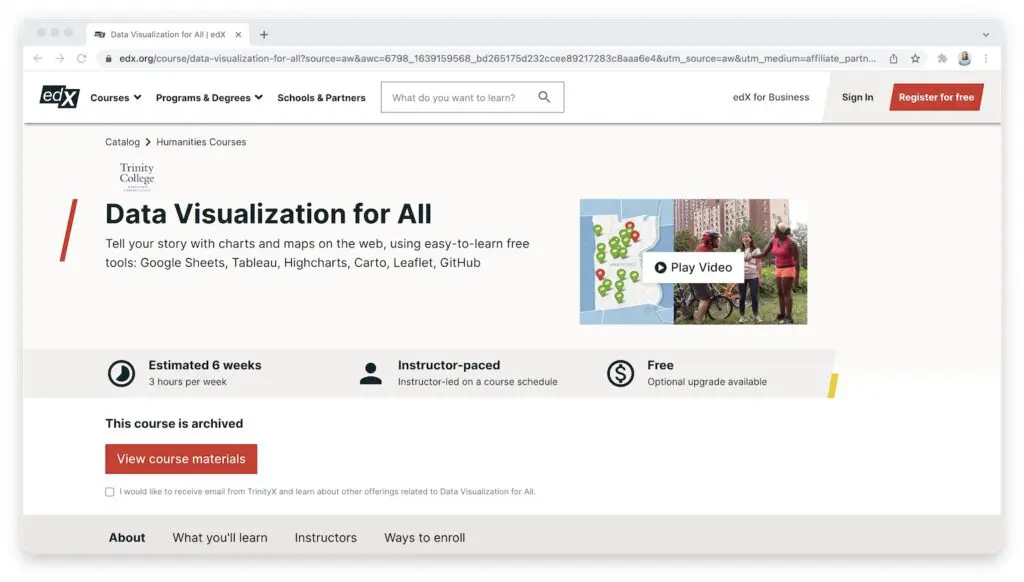
What the course covers:
Learn how to design interactive charts and customized maps for your website using Google Sheets, Tableau, Highcharts, Carto, Leaflet, GitHub
Course facts:
- Course Name: Data Visualization for All
- Platform: edX
- Instructed by: Jack Dougherty, Stacy Lam, David Tatem
- Price: Free (add a verified certificate for $49)
- Skill level: Beginner
- Enroll in the course here
Why this course?
The course is taught by Trinity College faculty, and real-world examples are drawn from their students working with community organizations in Hartford, Connecticut.
➡️ Where to learn it: Visualize Data with Python on Codecademy
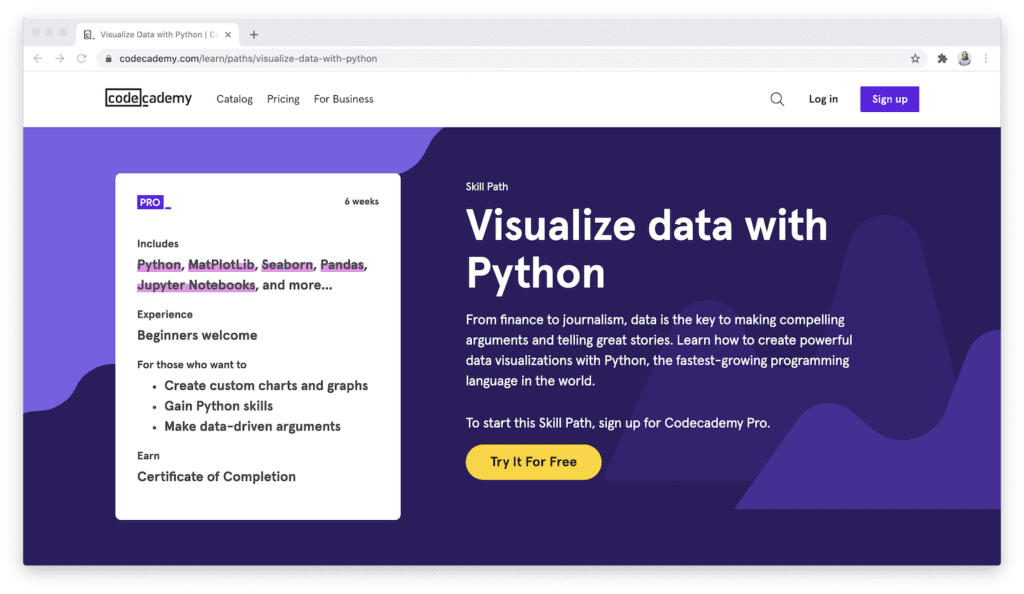
What the course covers:
Learn how to create powerful data visualizations with Python: create custom charts and graphs, learn theories and techniques to make compelling, data-driven arguments, and learn how to quickly and efficiently process huge data sets.
Course facts:
- Course Name: Visualize Data with Python
- Platform: Codecademy
- Price: Free with a 7-day trial of Codecademy Pro, then $19.99/month
- Skill level: Beginner
- Enroll in the course here
Why this course?
This Skill Path will fast-track your learning journey with hand-picked modules that will show you exactly what you need to know. You’ll get step-by-step guidance, and you’ll finish with a completion certificate to show off your new skills.
☝️ Back to the table of contents
Top Tech Skill #6: Network and Information Security (Cybersecurity)
For any company that collects customer information or deals with sensitive data of their own, keeping networks secure is paramount.
When data breaches do happen, they can be big, newsworthy, and costly for the company to recover from. The number of data breaches in 2021 exceeded all of 2020’s breaches by October 2021 (that’s a 17% increase) and companies famously hacked in the past include Sony, LinkedIn, Chipotle, and others.
Research also shows that remote work was the source of up to 20% of cybersecurity attacks in 2020. In fact, 24% of employers in one survey had to spend money to address security incidents after shelter-in-place orders spurred the sudden necessity of telework.
These situations and the rise in work from home underscore just how critical it is for companies to keep their network security up to par, and make cybersecurity one of the most-needed jobs and one of the top technology skills in demand in 2022. Within just one year, company demand for security engineers has increased by 132%.
Unfortunately for those companies, right now there is a shortage of people trained in network security. Fortunately for you, that means there’s a gap in the market you can fill.
If you’re curious about filling that gap, read my ultimate guide to starting a career in cybersecurity or buy some of these cybersecurity books.
Start coding now
Stop waiting and start learning! Get my 10 tips on teaching yourself how to code.
🌟 Quick facts about cybersecurity as a tech career:
- Average salary: $103,763 (security engineer)
- 4 of the 15 top-paying IT certifications are focused on security.
- Demand for security professionals is far outpacing supply: the talent gap in this field in 2021 was an estimated 2.7 million unfilled positions.
- Information security analyst jobs are projected to grow 33% percent from 2020 to 2030 — which is much faster than average
- In part due to such a massive shortage, damage from cyber crimes are anticipated to cost the world $10.5 trillion annually by 2025. This is a career where you can truly make an impact.
➡️ Where to learn it: Essentials of Cybersecurity on edX
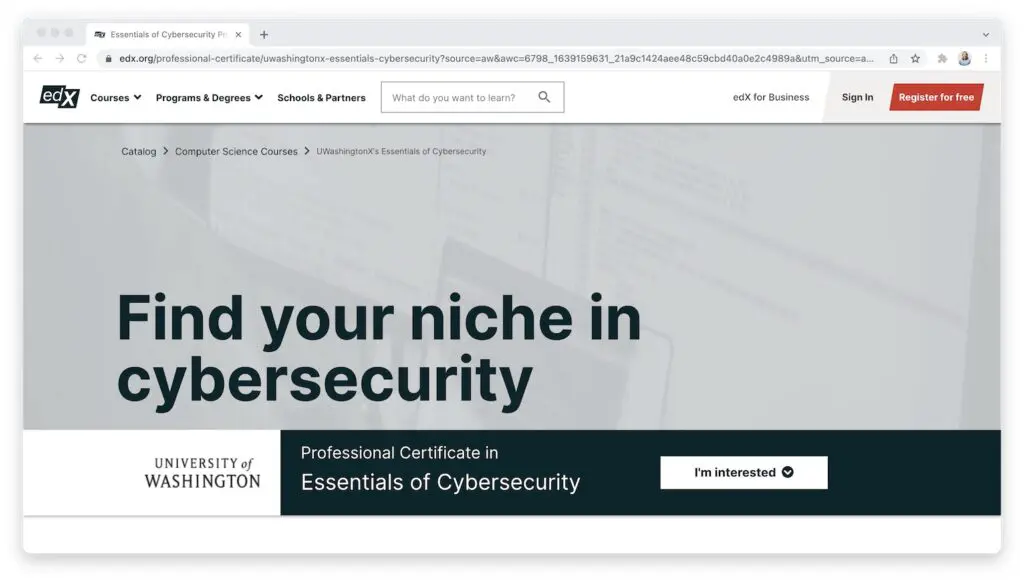
What the program covers:
The fundamentals of networks, systems administration, how to mitigate vulnerabilities, how to perform digital forensic analysis, risk assessment, etc.
Course facts:
- Program Name: Essentials of Cybersecurity
- Platform: edX
- Instructed by: University of Washington
- Price: $716.40
- Skill level: Intermediate (must have a STEM Bachelor’s degree or 5 years of work experience in a technical environment)
- Enroll in the course here
Why this course?
It’s a professional certificate program made up of four courses. You’ll better understand the field of cybersecurity, what roles are available, and what cybersecurity career path is right for you.
☝️ Back to the table of contents
Top Tech Skill #7: Cloud Computing/AWS
Cloud computing jobs are on the rise because more and more companies are switching from the classical server infrastructure to cloud solutions. According to Forrester Research, the market for global public cloud services will reach $482 billion in 2022 (up 21.7% from 2021).
Not only are companies transitioning to the cloud, but many companies are building their products and services directly in the cloud instead of switching later. That means cloud-native architecture skills will be some of the best skills to learn in 2022 and beyond.
Amazon Web Services is one of these cloud platforms, featuring content delivery, database storage, networking, and more–over 200 services in total. Since it is currently the biggest platform, we’ll highlight some specific facts about AWS in this section (and give an extra course recommendation for it!).
AWS specialists are usually engineers, cloud architects, or system administrators. IT professionals who are AWS-certified earn more than their non-certified counterparts. It’s one of the most profitable skills an IT employee can learn to level up their tech career.
🌟 Quick facts about cloud computing as a tech career:
- Average salary: $117,897 for cloud engineers
- The most in-demand cloud computing skills are Amazon Web Services (AWS), Java, Linux, software development, DevOps, Docker, and Infrastructure as a Service (IaaS).
- Big companies using AWS include Intuit, Netflix, GE Oil & Gas, and Time, Inc.
- AWS has the dominant market share of the cloud computing industry worldwide, with an active customer base in 190+ countries.
➡️ Where to learn general cloud computing: Cloud Computing Specialization on Coursera
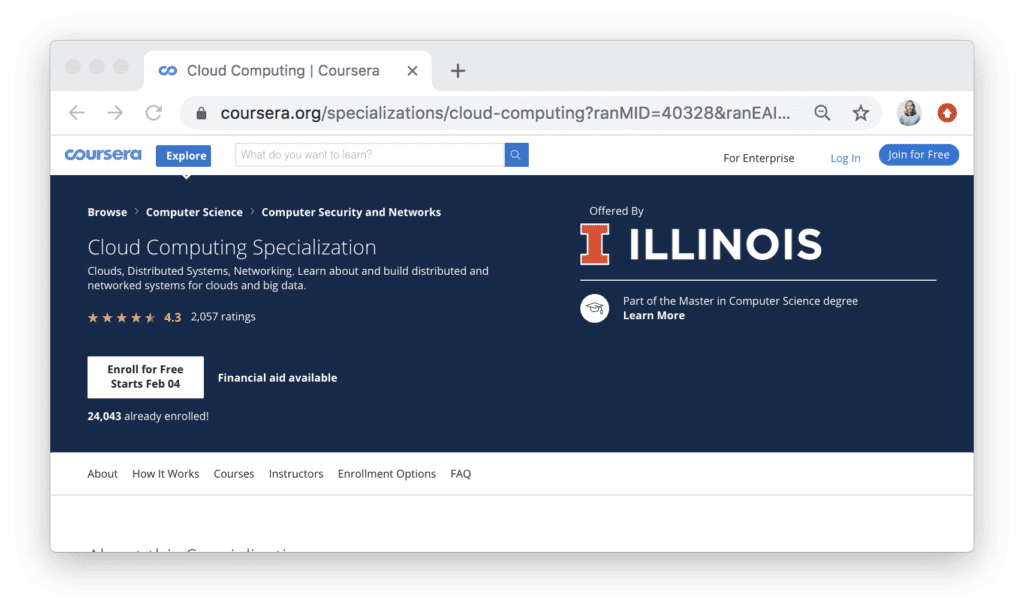
What the course covers:
Clouds, Distributed Systems, Networking. Learn about and build distributed and networked systems for clouds and big data.
Course facts:
- Course Name: Cloud Computing Specialization
- Platform: Coursera
- Instructed by: Reza Farivar, Ankit Singla, Indranil Gupta, P. Brighten Godfrey and Roy H. Campbell
- Price: $49 per month with Coursera subscription
- Skill level: Intermediate
- Enroll in the course here
Why this course?
Hands-on activities, taught by computer science professors
➡️ Where to learn Amazon Web Services: Amazon Web Services (AWS) Fundamentals for System Administrators on Pluralsight
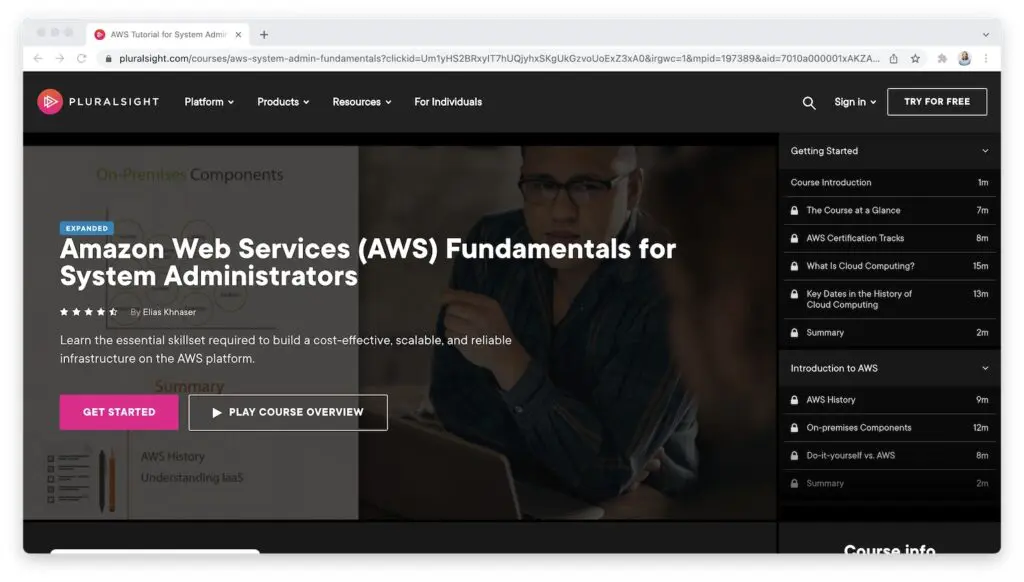
What the course covers:
Core AWS skills and concepts needed to begin working with AWS and to achieve AWS certification.
Course facts:
- Course Name: Amazon Web Services (AWS) Fundamentals for System Administrators
- Platform: Pluralsight
- Instructed by: Elias Khnaser
- Price: Free
- Skill level: Intermediate (requires working knowledge of virtualization, networking essentials, and general systems administration)
- Enroll in the course here
Why this course?
You’ll have a solid understanding of how various AWS services are architected and how you can use them.
Want more choice? Here are some more recommended AWS courses.
☝️ Back to the table of contents
Top Tech Skill #8: Extended Reality (Virtual Reality and Augmented Reality)
Virtual reality and augmented reality—the collective term is extended reality, or XR—are trending to be useful for more than just entertainment in the future. Marketing, advertising, health care, and manufacturing are some industries that have already begun adopting XR hot technologies.
According to Hired’s 2019 State of Software Engineers report, demand for AR and VR engineers surged by an incredible 1,400%. But a little under just one year prior (from Feb ‘18-Feb ‘19), job searches had actually decreased by 13.48% for these roles. This implies that while jobs in this area are skyrocketing, the number of job-hunting candidates hasn’t had time to keep up, presenting a good opportunity for those who want to train for this top tech skill now.
For the near future, AR is looking to outpace VR for growth and profitability. Reports predict that the global VR gaming market size will be worth $45.09 billion by 2025, while AR will be worth a stunning $133 billion by 2022.
🌟 Quick facts about Extended Reality (XR) as a tech career:
- Average salary: $72k for VR and $82k for AR
- According to Statista, the market size was around $6.1 billion in 2016 but is expected to reach $72.8 billion by 2024.
- If you have programming skills, consider learning Unity to help develop skills. They provide free tutorials.
- Companies like Google, Facebook, Snap (Snapchat), NVIDIA and HTC are some top companies using XR.
➡️ Where to learn it: Extended Reality (XR) – Building AR | VR | MR Projects on Udemy
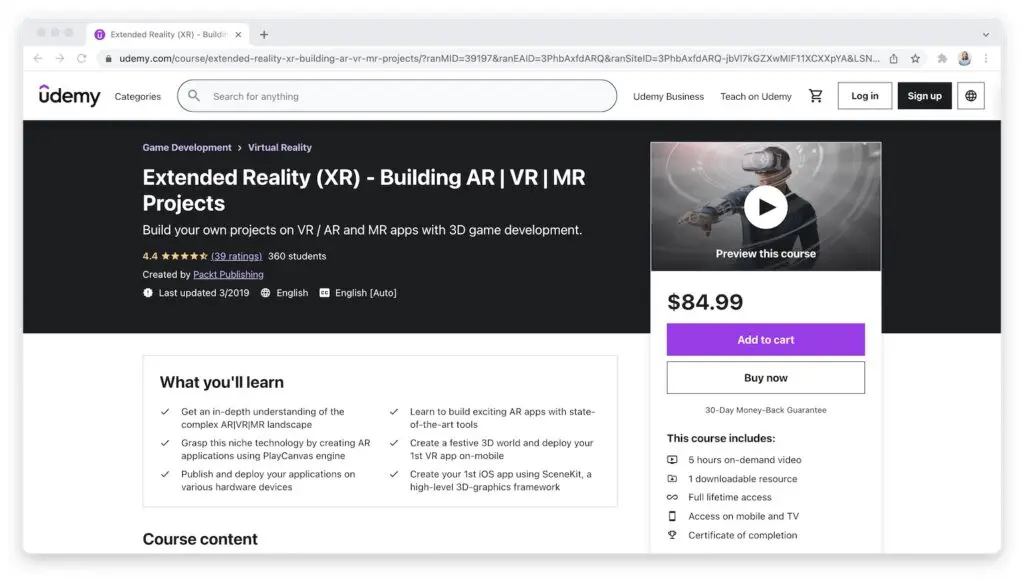
What the course covers:
Learn how to make VR and AR apps with 3D game development. You’ll gain a better understanding of the complex landscape of extended reality, build your own 3D world and deploy your own applications.
Course facts:
- Course Name: Extended Reality (XR) – Building AR | VR | MR Projects on Udemy
- Platform: Udemy
- Instructed by: Packt Publishing
- Price: $84.99 (although Udemy often has sales on)
- Skill level: Beginner/Intermediate (Some prior familiarity with AR/VR frameworks will be useful but not mandatory.)
- Enroll in the course here
Why this course?
It’s a relatively short course (5 hours of content) that will level up your game development skills.
☝️ Back to the table of contents
Top Tech Skill #9: Internet of Things (IoT)
In the broadest sense, the term IoT encompasses everything connected to the internet, but it is increasingly being used to define objects that “talk” to each other.
“Simply, the Internet of Things is made up of devices—from simple sensors to smartphones and wearables—connected together,” says Matthew Evans, the IoT program head at techUK.
Everything that’s connected to the internet can be hacked, which is why security is one top concern with these devices. California and the UK introduced legislation in 2019 to make IoT devices safer and more secure. Plus, the Internet of Things (IoT) Cybersecurity Improvement Act of 2020 requires agencies to increase cybersecurity for IoT devices owned or controlled by the federal government. By December 5, 2022, all government agencies can no longer renew procurement contracts with companies whose IoT devices do not comply with certain standards and guidelines.
Cybersecurity professionals who specialize in IoT will likely be highly sought after for this reason.
During the pandemic, 79% of US businesses launched new IoT projects as a direct result of COVID-19. Not only that, but 84% of businesses who had already adopted IoT started increasing the pace at which they launched projects due to the pandemic.
🌟 Quick facts about IoT as a tech career:
- Average salary: $102k for professionals with an IoT specialty
- The IoT market grew to $761.4 billion by 2020 and is expected to reach $1.39 trillion by 2026
- The McKinsey Global Institute predicts that IoT will have a total economic impact of up to $11 trillion by 2025.
- By 2025, more than 75 billion IoT devices will be connected to the web
➡️ Where to learn it: Internet of Things (IoT) on edX
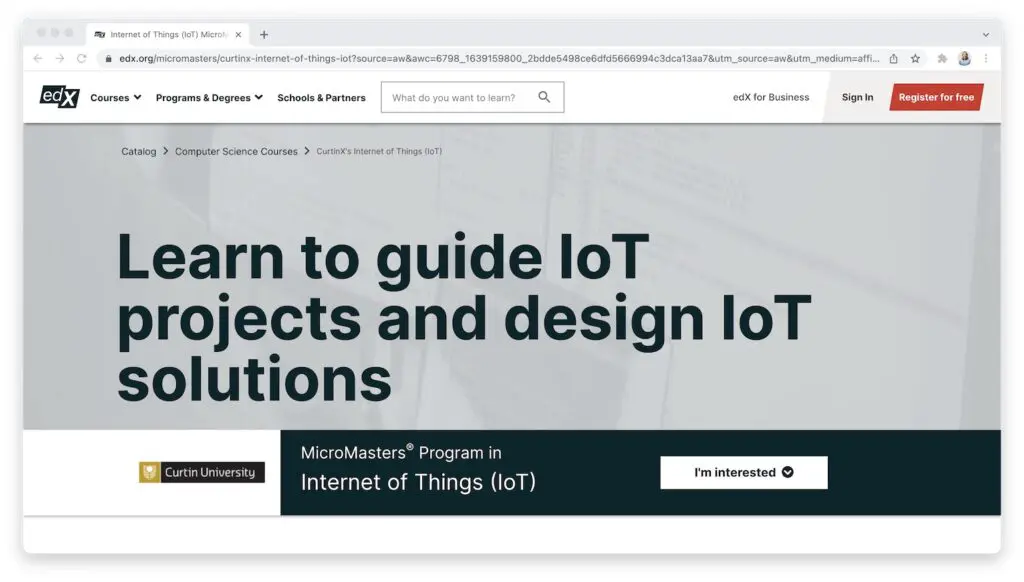
What the course covers:
Design IoT solutions and networks, identify components required, understand how data management fits in, analyze security risks, and ultimately produce a fleshed-out idea that’s ready to prototype
Course facts:
- Course Name: Internet of Things (IoT) MicroMasters program
- Platform: EdX
- Instructed by: Curtin University
- Price: $1,389.60 USD for the entire program
- Enroll in the course here
Why this course?
The MicroMasters program—taught by a range of professors, specialists and lecturers from Curtin University—includes 6 self-paced IoT courses, live discussions, remote access to real laboratory equipment for practical sessions. The program is credit-eligible for Curtin University Master’s degrees.
☝️ Back to the table of contents
Top Tech Skill #10: UI/UX Design
While they’re in the same family, UI and UX are different. UI (user interface) specialists design interfaces for websites and apps to be visually appealing, flow well, and be easy for users to navigate. UX (user experience) specialists do a lot of research and testing to consider every element of how the user will interact with the company and website, coordinating with developers and UI designers.
This type of career is perfect for those who want a creative-meets-analytical type of role (graphic design meets A/B testing and so on).
Ultimately, UI is better for those who want to focus on the visuals, layout, and general look and feel of a page or product. UX is better for those who want to use analysis and testing to help a business seamlessly meet their users’ needs.
Start coding now
Stop waiting and start learning! Get my 10 tips on teaching yourself how to code.
🌟 Quick facts about UI/UX as a tech career:
- UX design is one of the top five in-demand hard skills according to LinkedIn
- There are 49,434 UX designer jobs in the United States alone
- UX and UI designers have many specific tools of the trade–like these design tools.
- Demand for UX/UI skills is mostly in mobile platforms, but demand for innovative design in VR, AR, AI, and wearables is growing
➡️ Where to learn it: User Experience Design Fundamentals on Udemy
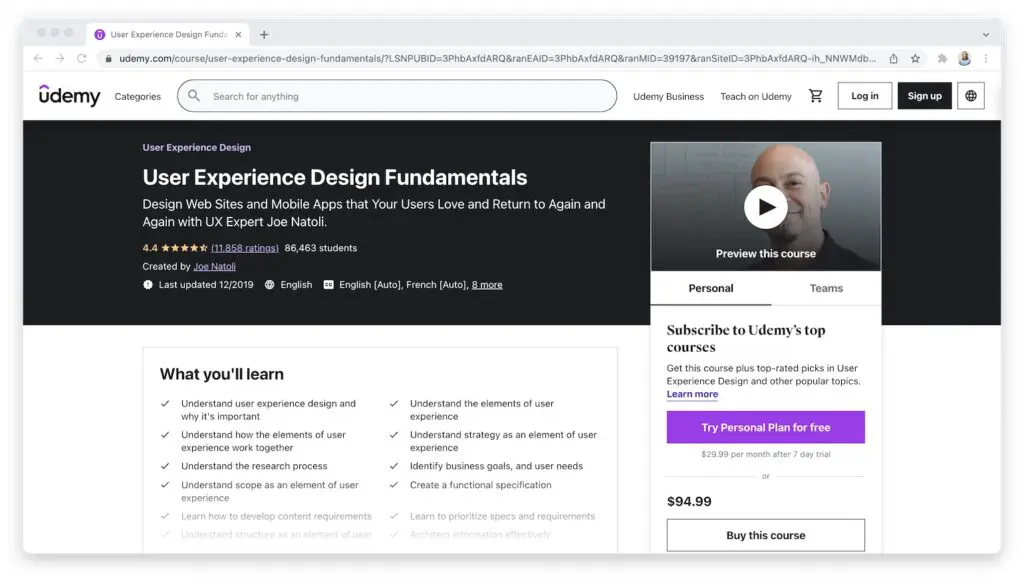
What the course covers:
The critical elements of user experience–strategy, scope, structure, skeleton, and surface. Learn the basics (e.g. what UX design is and why it’s important), strategy/theory (e.g. use of color and typography), and implementation (e.g. how to create wireframes).
Course facts:
- Course Name: User Experience Design Fundamentals
- Instructed by: Joe Natoli
- Price: $94.99 (but Udemy often has sales, especially around holidays)
- Skill level: Beginner
- Enroll in the course here
Why this course?
It has a 4.4-star rating from over 11,000 ratings, with over 86,000 students enrolled. The instructor has been helping Fortune 100, Fortune 500, and various government organizations with UX design for nearly three decades.
☝️ Back to the table of contents
Top Tech Skill #11: Mobile Development
There are 6.378 billion smartphone users in the world today, and that number is continuing to grow every year. This means that companies who want to stay relevant don’t just need websites; they need apps. Having mobile development technology skills also comes with the perk that if you can build apps for others, you can build and sell your own as well–so it’s an ideal career path for aspiring entrepreneurs.
One interesting direction that mobile apps are headed in is augmented reality. Apps like Pokémon Go and Harry Potter: Wizards Unite game engage with the real world, blending technology and reality. Another interesting development in mobile apps in 2021? Contact tracing apps that help slow the spread of COVID-19.
If you want to start learning mobile development, first figure out which is the best mobile app development language or platform for your needs. Then check out these 21 mobile app development courses.
🌟 Quick facts about mobile development as a tech career:
- Average salary: $120,517
- At the time of writing there are over 26,000 mobile developer jobs posted on Indeed.
- The app economy will add 440,000 new jobs to the US workforce by 2024; the iOS app economy created a staggering 300,000 new US jobs during the pandemic
- The future of mobile development goes beyond phones: wearable technologies, the Internet of Things, beacon technology, increase in use of VR/AR, and more.
- Mobile engineer is the #8 best job in America for 2021 according to Glassdoor
➡️ Where to learn it: Udacity’s Become an iOS Developer Nanodegree
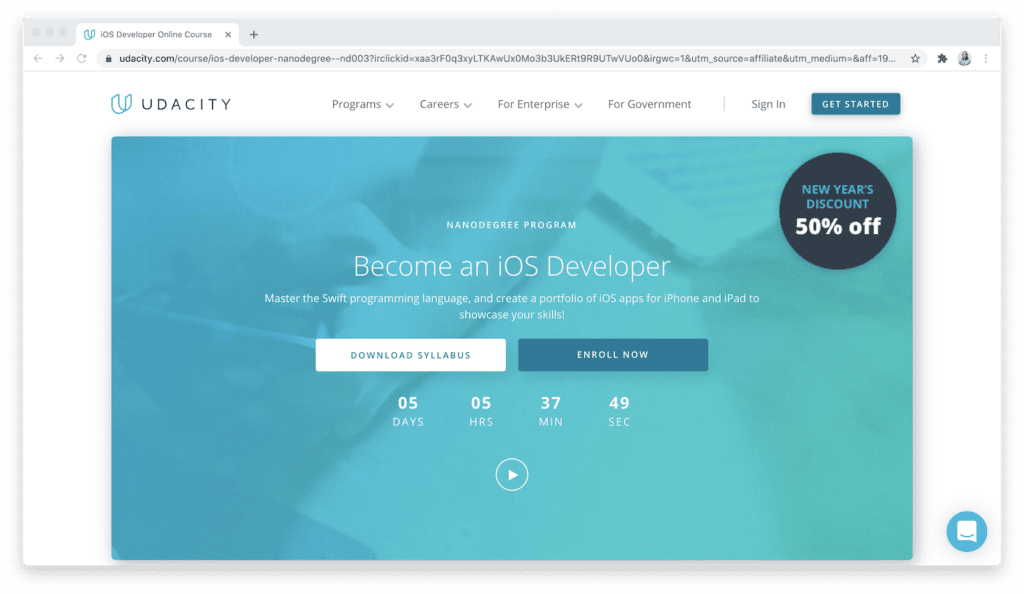
What the course covers:
Swift is the language of iOS, created by Apple. You can use the language to build applications for the iPhone, iPad, Apple Watch, and more. Build your own apps or land a full-time job at a company that uses Swift.
Course facts:
- Course Become an iOS Developer
- Platform: Udacity
- Price: $399/month or $2,034 for 6 months of access
- Skill level: Beginner
- Enroll in the course here
Why this course?
Learn how to program from absolute scratch using Swift and learn many fundamental concepts that will get you started writing code immediately. (No prior programming experience is needed.)
☝️ Back to the table of contents
Top Tech Skill #12: Blockchain
Originally devised for the digital currency Bitcoin, blockchain has evolved. The tech community is now finding other potential uses for the technology, such as peer-to-peer payments, crowdfunding, file storage, identity management, digital voting, etc. Learn more about blockchain/cryptocurrency jobs in this article.
“With platforms like Ethereum taking the lead, more and more companies need developers who understand the blockchain, smart contracts, and can build decentralized applications,” writes Anna Belaya.
Some of the blockchain skills you should know include networking, cryptography computing, database design, and programming languages ranging from Java, JavaScript, and C++ to Go, Solidity, and Python.
🌟 Quick facts about blockchain as a tech career:
- Average salary: $154,550 per year
- According to Gartner, the business value of blockchain will be $3.1 trillion in by 2030.
- Between late 2017-late 2018, demand for blockchain engineers increased by 400 percent
- Tech giants like Facebook, Amazon, IBM and Microsoft are working on blockchain
➡️ Where to learn it: Blockchain Specialization on Coursera
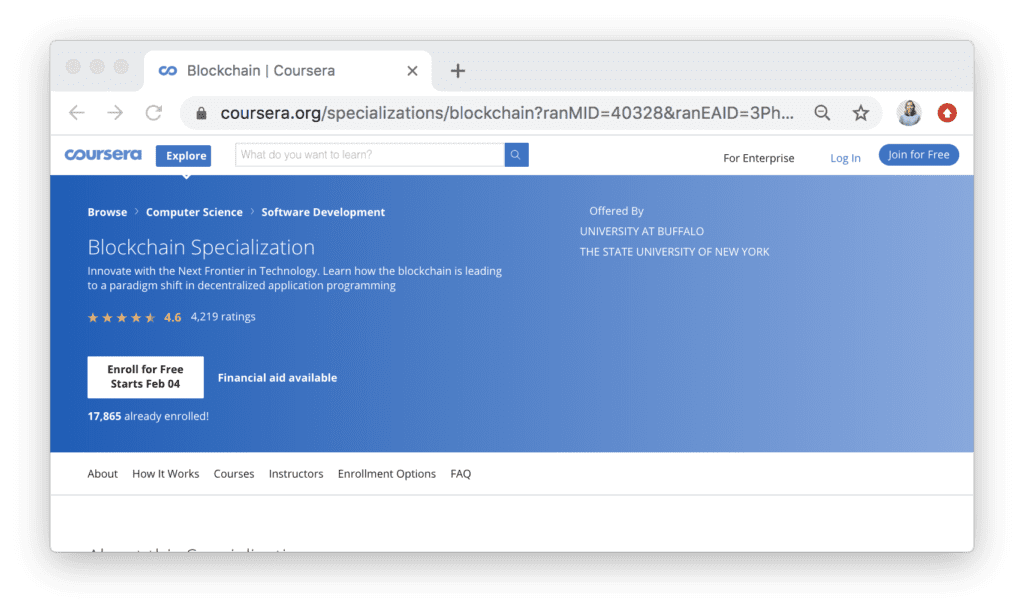
What the course covers:
Broad intro into what blockchain is, including how to design and program smart contracts and decentralized applications
Course facts:
- Course Name: Blockchain Specialization
- Platform: Coursera
- Instructed by: Bina Ramamurthy
- Price: $49 per month with Coursera subscription
- Skill level: Beginner/Intermediate (requires knowledge of at least one modern, high-level programming language)
- Enroll in the course here
Why this course?
Includes hands-on activities and is taught by a computer science professor at University at Buffalo.
➡️ Where to learn it: Become a Blockchain Developer on Udacity
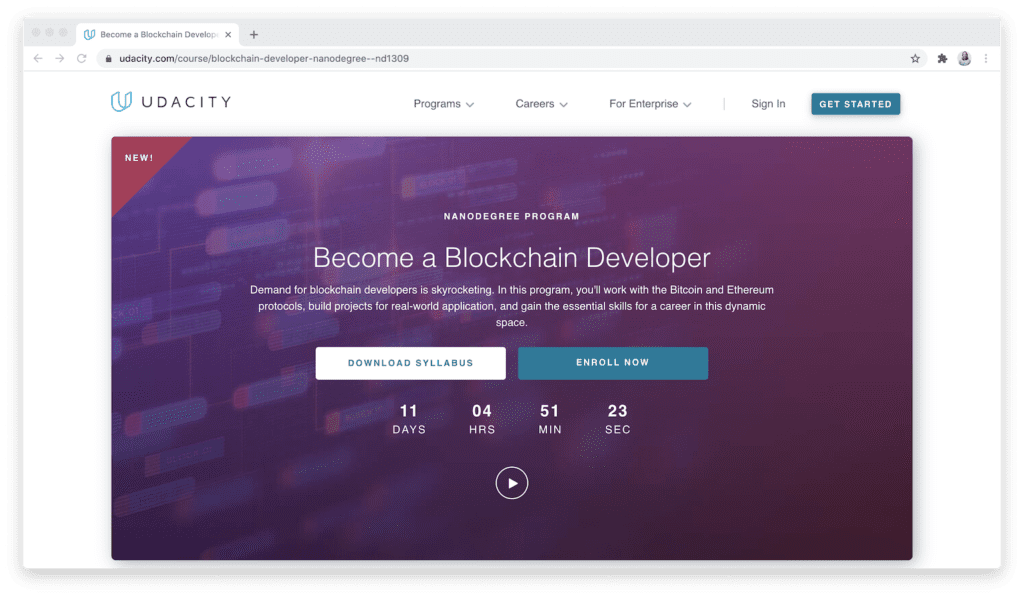
What the course covers:
In this program, you’ll work with the Bitcoin and Ethereum protocols, build projects for real-world application, and gain the essential skills for a career in this dynamic space.
Course facts:
- Course Name: Become a Blockchain Developer
- Platform: Udacity
- Price: $399 per month or $1,356 for 4 months of access
- Skill level: Intermediate (requires knowledge of object-oriented programming and developing web apps in Javascript)
- Enroll in the course here
Why this course?
This course will teach you all the top technical skills you need for a career in blockchain development within an average of 4 months.
☝️ Back to the table of contents
Top Tech Skill #13: Quantum Computing
Quantum computing is a mix of physics, engineering, math and computer science.
If you’re okay with a little uncertainty in your career (and you enjoy science fiction), quantum computing is a field to consider. “The industry has a ways to go,” writes Sophia Chen. “They have a timeline, sort of, give or take a few decades. And at the moment, their roadmap has at least one glaring pothole: a lack of trained people.”
However, this provides an opportunity for you to help move the needle forward. Jeremy O’Brien, physicist and professorial research fellow at the University of Bristol, says that quantum computers could outperform everyday computers in less than 10 years. The Research Centre of Finland even believes that quantum computing could help minimize the impact of epidemics or pandemics in the future.
🌟 Quick facts about quantum computing as a tech career:
- Average salary: $96,897 per year
- Current quantum computing roles include software engineers, researchers, experimental scientists, and programmers.
- IBM is on the path to building a full-fledged quantum computer, saying it will build a 1000-qubit quantum computer by 2023
- You can contribute to Qiskit Terra and Qiskit Aqua code and algorithms to start getting involved with quantum computing and get noticed by hiring managers.
➡️ Where to learn it: Introduction to Quantum Computing for Everyone on edX
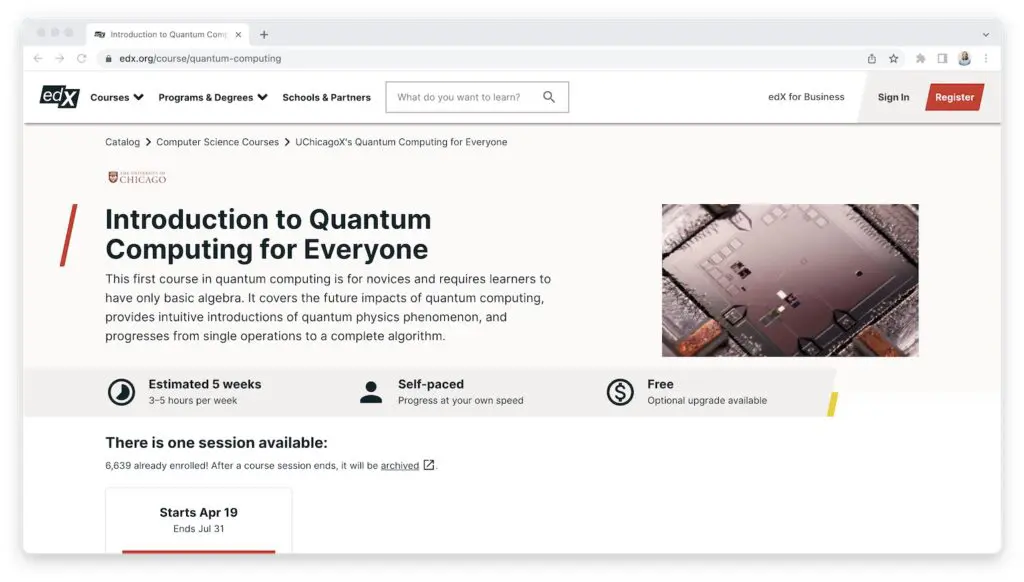
What the course covers:
Intro to quantum physics phenomenon and covers topics from single operations to a complete algorithm.
Course facts:
- Course Name: Introduction to Quantum Computing for Everyone
- Platform: edX
- Instructed by: Diana Franklin & Kate Smith
- Price: Free (optional upgrade available)
- Skill level: Intermediate (requires knowledge of basic algebra)
- Enroll in the course here
Why this course?
Taught by two women in tech. Provides an intuitive introduction to the impacts, underlying phenomenon, and programming principles that underlie quantum computing.
☝️ Back to the table of contents
Top Tech Skill #14: Robotics
As a robotics engineer, you can specialize in software or hardware roles, working on virtual or physical bots. Physical robotics can encompass medical equipment, exploration bots, animatronics for films or amusement parks, automated manufacturing equipment, and more.
Virtual bots can exist in software and online to help automate tasks like customer service, virtual assistance, etc. You’ll notice an overlap with AI in this space.
Robots have also become “essential workers” during the pandemic, monitoring COVID-19 patients, making deliveries, checking people’s temperatures, and more. There’s even a fully automated swab robot in the works that will administer COVID-19 tests on patients. This increased demand for robots means demand for robotics engineers is increasing.
Learn more about how to become a robotics engineer in this podcast episode with Camille Eddy, who is a robotics and product engineer who speaks internationally about inclusion in the tech community).
Start coding now
Stop waiting and start learning! Get my 10 tips on teaching yourself how to code.
🌟 Quick facts about robotics as a tech career:
- Average salary: $85,047 for robotics engineers
- LinkedIn reports that with the rise of both virtual and physical bots, the robotics industry has seen a 40% annual growth.
- The robotics engineer job market is expected to grow by 6.4% between 2016 and 2026
- It’s estimated that over the next 10 years, the US will need 12,500 robotics engineers
➡️ Where to learn it: Robotics Specialization on Coursera
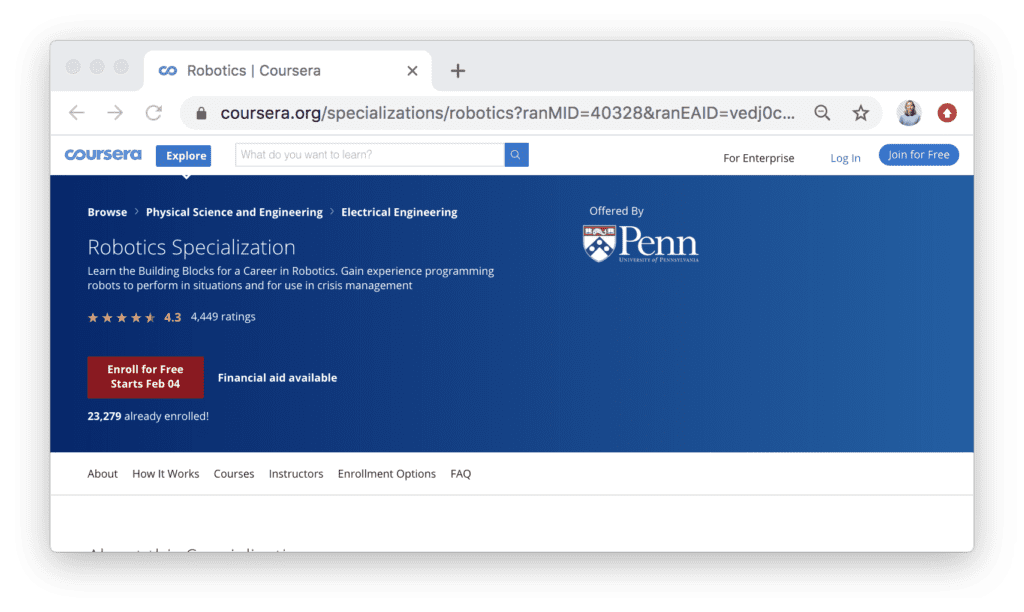
What the course covers:
Learn how robots operate, adjust their movements across a variety of terrains, serve useful real-world functions in scenarios like disaster recovery and healthcare, and so on. For a course project, you’ll learn how to program a robot to move and fly.
Course facts:
- Course name: Robotics Specialization
- Platform: Coursera
- Instructed by: Jianbo Shi, Daniel Lee, Daniel E. Koditschek, Kostas Daniilidis, Vijay Kumar, CJ Taylor, Sid Deliwala
- Price: $39 per month
- Skill level: Beginner
- Enroll in the course here
Why this course?
This specialization is comprised of 6 courses taught by a collection of professors from the School of Engineering at the University of Pennsylvania.
➡️ Where to learn it: Become a Robotics Software Engineer on Udacity
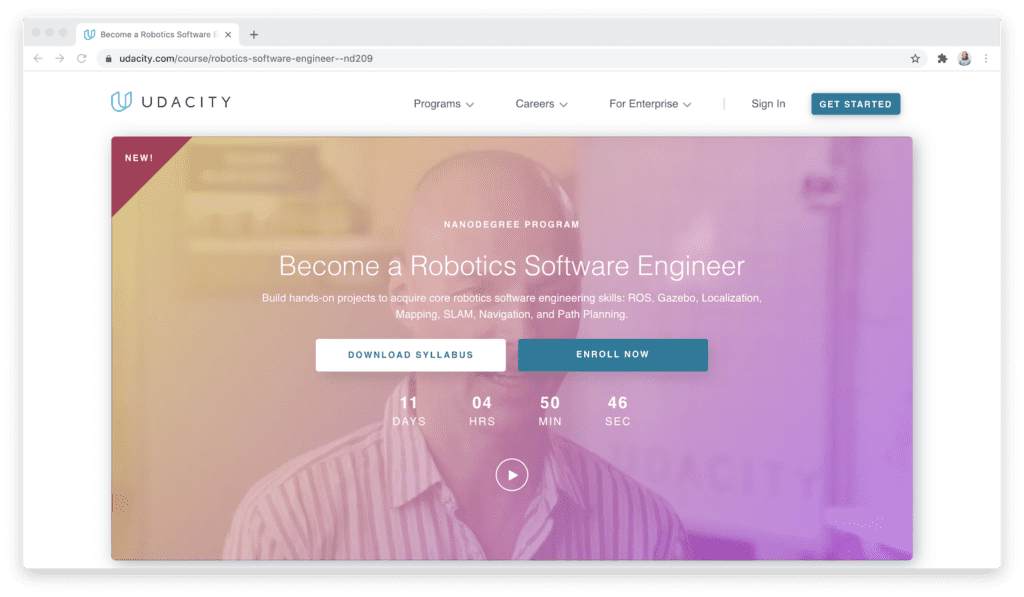
What the course covers:
Build hands-on projects to acquire core robotics software engineering skills: ROS, Gazebo, Localization, Mapping, SLAM, Navigation, and Path Planning.
Course facts:
- Course Name: Become a Robotics Software Engineer
- Platform: Udacity
- Price: $399 per month or $1,356 for 4 months of access
- Skill level: Intermediate
- Enroll in the course here
Why this course?
Begin your exploration into the world of robotics software engineering with a practical, system-focused approach to programming robots using the ROS framework and C++. In addition, you’ll learn and apply robotics software engineering algorithms such as localization, mapping, and navigation.
☝️ Back to the table of contents
Top Tech Skill #15: Product Management
There’s no single job description of product management; roles will likely look different across different companies and product types (software, apps, physical products, etc). Since almost every company sells some kind of product, these are consistently some of the most in-demand skills.
At its core, product management is about making a product the best it can be. That may entail considering market demand, conducting surveys and potential user tests, acting as a liaison between developers and designers assigned to the product, etc.
Especially if you’re working on a technical product, having the ability to understand and speak tech terminology will make you more successful.
Learn more about what product management involves here, including what exactly a product manager does and how to get into this role.
Learn more about how to become a product manager here (a podcast episode with Sam Gimbel, who started out by studying neuroscience and became a product manager and later the co-founder of his own businesses).
🌟 Quick facts about product management as a tech career:
- Average salary: $99,519 for a software product manager
- COVID-19 has accelerated digital adoption by major firms by as much as 5 years, which means demand for product managers is likely to increase
- Glassdoor lists it as the #3 best job in America for 2021
➡️ Where to learn it: Become a Product Manager | Learn the Skills & Get the Job on Udemy
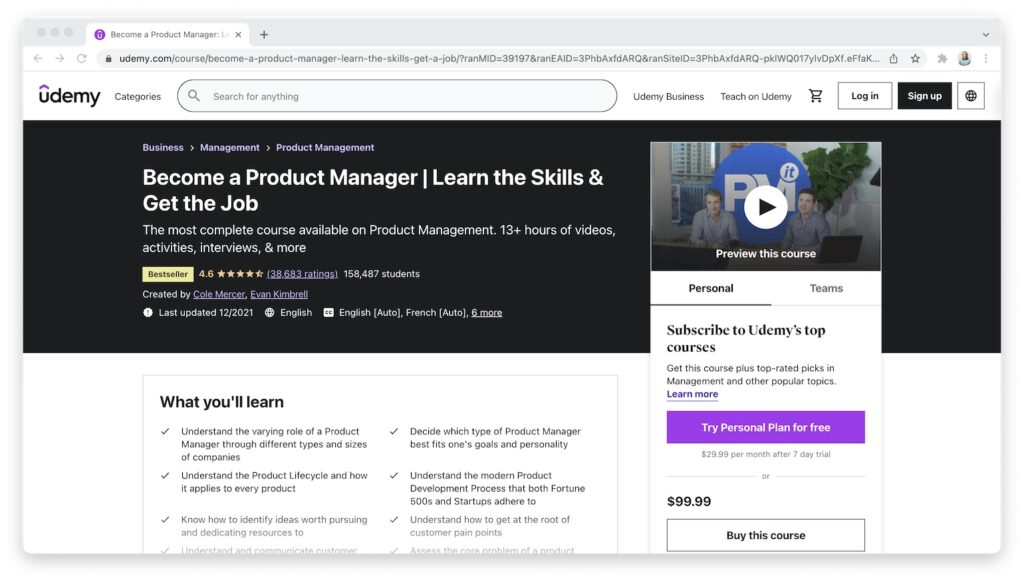
What the course covers:
Learn all the skills involved in product management, from idea through execution. You’ll become familiar with the processes and tools involved in market research, prototyping, metric measuring, understanding core tech concepts, leading a team, and more.
Course facts:
- Course name: Become a Product Manager | Learn the Skills & Get the Job
- Platform: Udemy
- Instructed by: Cole Mercer, Evan Kimbrell
- Price: $99.99 (but Udemy often has sales, especially around holidays)
- Skill level: Beginner, but familiarity with basic business concepts is helpful
- Enroll in the course here
Why this course?
In addition to teaching the skills, the course dedicates time to the job-search process as well, giving tips on the resume, portfolio, interview, and what to look for in product management jobs. Over a thousand students who have taken this course now work as product managers.
☝️ Back to the table of contents
Top Tech Skill #16: Salesforce/CRMs
Salesforce is one of the world’s top 10 software companies by annual revenue, so there are a lot of opportunities for work in this space. CRMs, or customer relationship management solutions, provide companies with efficient ways to manage their sales, marketing, and customer support.
Developers are able to build on existing Salesforce infrastructure to create applications and projects specific to the needs of their company.
#7 on LinkedIn’s emerging jobs report was Sales Development Representative, which mixes a traditional sales role with Salesforce technology expertise. As it’s not a purely technical role, it can be a good place to start within the broader universe of Salesforce.
Furthermore, demand for Salesforce developers has been seeing an increasing demand during the pandemic. “It’s not a coincidence that more organizations are looking to optimize and automate their business flows, especially during the COVID-crisis,” says Dmitriy Ogol via Salesforce Ben, “And Salesforce is known for being the best solution for doing so.”
On the podcast, listen to Zac Otero talk about transitioning into tech as a self-taught Salesforce admin.
🌟 Quick facts about Salesforce as a tech career:
- Average salary: $86,242 for a Salesforce developer
- Salesforce developer is #14 on Glassdoor’s best jobs in America for 2021
- International Data Corporation research showed that Salesforce would help create 3.3 million new jobs and generate more than $859 billion in new business revenues worldwide between 2016-2022.
➡️ Where to learn it: Salesforce Development Training for Beginners on Udemy
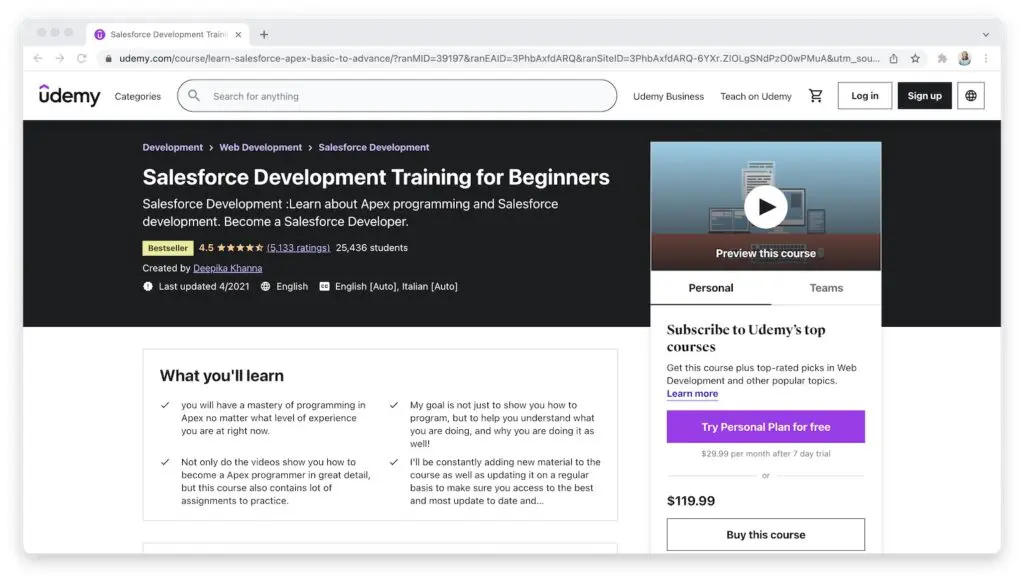
What the course covers:
Programming in Apex (the language of Salesforce), creating a Salesforce developer’s account, and all the features you can implement.
Course facts:
- Course name: Salesforce Development Training for Beginners on Udemy
- Platform: Udemy
- Instructed by: Deepika Khanna
- Price: $119.99 (but Udemy often has sales, especially around holidays)
- Skill level: Beginner
- Enroll in the course here
Why this course?
Assumes no prior Salesforce experience and provides real-world examples to illustrate the concepts you’re learning.
☝️ Back to the table of contents
Top Tech Skill #17: Low-Code Platforms
Forrester predicts that 75% of all enterprise software will be built with low-code technology in 2021. During the pandemic, for example, companies had to rely on low-code solutions (instead of waiting for month-long code sprints) to come up with solutions to problems related to COVID-19 (e.g., increased demand). There will be a continued need for this as the pandemic starts to wind down in 2022 and beyond.
What exactly is low-code? Low-code involves “coding” using a drag-and-drop interface, pre-built templates and other visual elements that take much less time than traditional coding. Popular low-code platforms include Salesforce (#16 on our list), Shopify, Microsoft Power Apps, Zoho Mendix, and IBM Automation Platform.
The idea is that low-code platforms help developers take mundane tasks off their plate and focus on more challenging problems. It also means people with more limited tech skills can build programs and make modifications to existing applications without knowing how to code in the traditional sense. Because companies are finding it harder to find software developers (and hiring budgets may be lower due to the pandemic), having low-code skills can make you stand out and be more efficient at your job.
🌟 Quick facts about low-code:
- 2021 has been dubbed “The Year of Low-Code” by many industry experts
- The low-code market is expected to increase from $10.3 billion in 2019 to $187 billion by 2030
- 72% of low-code developers create applications in three months or less
- By 2024, it is predicted that low-code application development will be responsible for more than 65% of application development activity
➡️ Where to learn it: Mendix : Low-code Application Development Course on Udemy
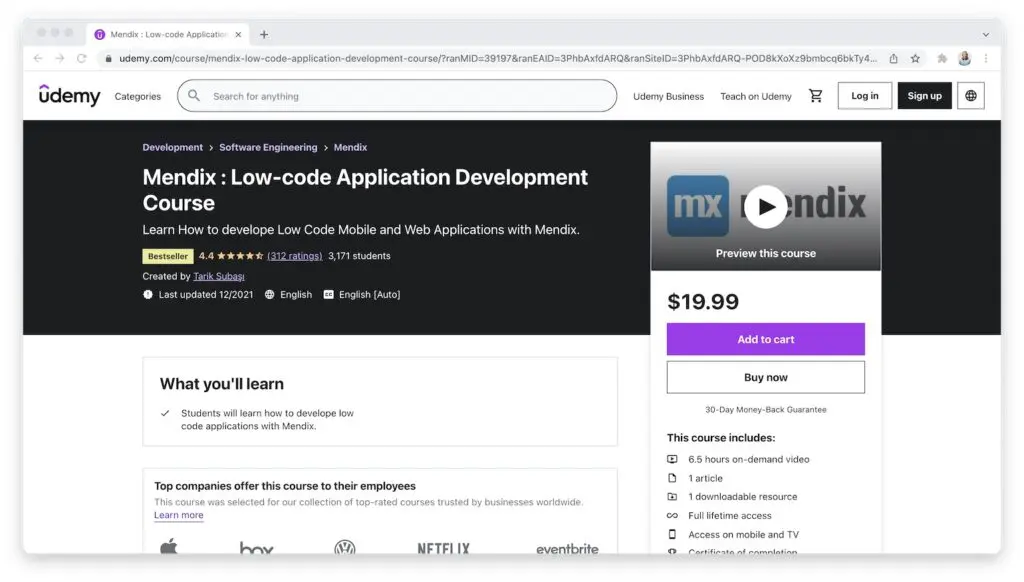
What the course covers:
How to develop low-code mobile and web apps using Mendix, a popular low-code platform used by businesses to develop apps quickly.
Course facts:
- Course name: Mendix: Low-code Application Development Course on Udemy
- Platform: Udemy
- Instructed by: Tarik Subaşı
- Price: $19.99
- Skill level: Beginner
- Enroll in the course here
Why this course?
Teaches practical applications of Mendix from the get-go.
☝️ Back to the table of contents
Top Tech Skill #18: Programming Languages in General
Having a foundation of programming language skills can open doors for you in a lot of different ways.
Glassdoor’s list of top jobs for 2021 includes a lot of the best tech jobs for the future. Java developer is their #1 best job, data scientist is #2, software engineer is #9, etc. Full-stack engineering has seen 35% hiring growth every year since 2015.
What Is the Ruby Programming Language? Pros, Cons & CoursesWhen it comes to specific skills, there are some notable trends:
- HTML and CSS are the easiest languages to start with if you’re new to coding
- Python is the fastest-growing language and second most popular on GitHub
- JavaScript is the most commonly used programming language eight years in a row
- Go is highly in demand, but low in supply; only 7% of developers work with it often
- Scala, Ruby, Typescript and Kotlin are also some top in-demand skills with comparatively low developer familiarity
Of course, the language that’s best for you to learn depends on your specific goals.
Start coding now
Stop waiting and start learning! Get my 10 tips on teaching yourself how to code.
Courses to Learn 17 Programming Languages
- HTML and CSS: HTML5 and CSS Fundamentals on edX (Free — add verified certificate for $199)
- JavaScript: JavaScript Path on Pluralsight ($29/month with a Pluralsight membership)
- Python: Introduction to Python Programming on Udacity (free)
- Java: Introduction to Programming in Java on edX ($402.30)
- C#: C# Path on Pluralsight ($29/month with a Pluralsight membership)
- PHP: PHP Essential Training on LinkedIn Learning ($34.99)
- Go: Programming with Google Go Specialization on Coursera ($49/month with a Coursera membership)
- Scala: Introduction to Scala on Datacamp (Free)
- Ruby: Ruby Core Curriculum at Launch School ($199/month)
- Typescript: TypeScript Fundamentals ($29/month with a Pluralsight membership)
- Kotlin: Kotlin Essential Training on LinkedIn Learning ($39.99)
- SQL: The Complete SQL Bootcamp on Udemy ($159.99 but often on sale)
- Swift: Swift Fundamentals on Pluralsight ($29/month with a Pluralsight membership)
- R: R Programming: Advanced Analytics In R For Data Science on Udemy ($84.99 but often on sale)
- C: Introduction to Programming in C Specialization on Coursera ($49/month with a Coursera membership)
- C++: C++ Essential Training on LinkedIn Learning ($49.99)
- Objective-C: Foundations of Objective-C App Development on Coursera ($39/month with a Coursera membership)
☝️ Back to the table of contents
Bonus: Soft Skills That Can Help Your Technical Career
These days, many tech professionals aren’t hidden away doing solitary work in cubicles—they work on teams. Thus, being self-aware of your people skills like communication, negotiation, listening skills, open-mindedness, and patience can help further your career just as much as a new certification.
These soft skills can also help get your foot in the door of an entry-level role like customer success specialist, where you can provide support to customers using a technical product. You can potentially use this knowledge of the product to your advantage while you study related tech skills with the goal of making a departmental transfer.
As AI and robotics become capable of automating more tasks, it can benefit you to specialize in uniquely human areas requiring creativity, empathy, critical thinking, storytelling, and so on.
Even if you aren’t gunning for one of these roles, taking courses to learn the skills involved could benefit you in ways you don’t even anticipate!
- Customer service: Customer Service Foundations on LinkedIn Learning ($19.99)
- Sales: Sales Training: Practical Sales Techniques on Udemy ($99.99 but often on sale)
- Storytelling/marketing: The Entrepreneur’s Guide to Storytelling in Marketing ($94.99 but often on sale)
- Learning efficiently: Learning to Learn [Efficient Learning] on Zero to Mastery ($39/month for access to ZTM’s entire course library)
- Communication: Communication Skills: Become More Clear, Concise, & Confident on Skillshare ($8.25/month billed annually but you can try for free with a 14-day trial!)
☝️ Back to the table of contents
FAQs About the Top Technologies to Learn in 2022
Got questions about the most in-demand skills for the future? Let’s answer some!
Why should I learn an in-demand skill in 2022?
There are tons of reasons to learn an in-demand tech skill. First, well — it’s in demand! Employers are actively looking for people with these skills, so having them can open up more opportunities for you. Second, if you know an in-demand tech skill that can bolster your current career, it can give you an advantage over others in the job market. Third, in-demand skills typically come with high salaries!
Which top tech skill should I learn?
It can be tough to decide which tech skill to learn, especially with so many options. A few ways to narrow it down include:
- Thinking about what you actually enjoy – for example, if you’d love to work with robots, learning robotics or AI would be a great option!
- What are you naturally good at? Are you good at math? Do you enjoy managing people? These can all help you decide.
- Consider the skills you already have and how they’d transfer to a new career / compliment a new skill.
- How fast you’d like to jump into a new career – some skills take longer than others to learn, so how much are you willing to commit?
- What salary are you hoping to get? Again, some skills are higher-paid than others, but this may not matter as much to you.
- What is your “dream job”? What career do you see as your end goal? Think of your ideal job and jot down all the skills you’ll need to achieve that dream.
Which top tech skills are the most future-proof?
Since the tech world is constantly changing, it’s impossible to tell for sure which future-ready skills will be in-demand for the longest amount of time. However, any of the skills on this list are as “future proof” as you can get. Even if any of these tech skills become obsolete, you can still take what you know about each skill to other areas of tech and apply them in other industries/jobs.
Aren’t robots/computers going to take over all our jobs anyway?
It may seem like robots/computers are taking over human jobs — self-driving cars, retail chatbots, etc. — but this is not entirely the case! There are still humans behind driverless cars, chatbots, and other types of automation. It has actually created more tech jobs!
According to a report from the World Economic Forum, 85M jobs will be replaced by machines with AI by 2025. That may sound scary, but the same report states that 97M new jobs will be created due to AI by that same year.
What are the best tech skills to learn for a career change?
When you want to make a career change into tech from an unrelated role, try finding a tech role that overlaps with things you’re already doing/already good at. Try some free tech/coding tutorials to check out a few skills you may be interested in and figure out if you like it.
If you’re still unsure, learn why Python is a good tech skill to learn for career changers. Python is often a great entry point to a ton of tech careers. Also, check out these 12 tips for making a career change later in life.
☝️ Back to the table of contents
Which Technology Skills Will You Learn This Year?
Any of these profitable technical skills will set you well on your way to a successful new tech career in 2022 and beyond. Now it just comes down to which is best suited for your personality and interests–and that one’s up to you :)
Whether you’re brand-new to coding and tech, or you have some experience already and are ready to narrow down and specialize in a specific area, there are a lot of opportunities to level up your IT skills without spending a fortune.
To get started, check out these 100+ amazing platforms where you can learn to code for free, or 54 coding books to add to your educational library!
Note: there are affiliate links in this post.

